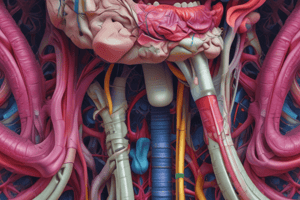Podcast
Questions and Answers
Which of the following is NOT a function of the larynx?
Which of the following is NOT a function of the larynx?
- Production of sound
- Filtering air (correct)
- Linking the pharynx and trachea
- Protection of airways from swallowed matter
What is the most superior space within the larynx?
What is the most superior space within the larynx?
- Vestibule (correct)
- Ventricle
- Rima glottidis
- Infraglottic cavity
Which cartilage is described as a complete ring of hyaline cartilage?
Which cartilage is described as a complete ring of hyaline cartilage?
- Cricoid cartilage (correct)
- Thyroid cartilage
- Arytenoid cartilage
- Epiglottis
The rima glottidis is best described as which of the following?
The rima glottidis is best described as which of the following?
The epiglottis is primarily responsible for which function?
The epiglottis is primarily responsible for which function?
Which of the following cartilages is NOT one of the three unpaired cartilages of the larynx?
Which of the following cartilages is NOT one of the three unpaired cartilages of the larynx?
What anatomical structure is also known as the 'Adam's apple'?
What anatomical structure is also known as the 'Adam's apple'?
Which structure extends from the lateral edges of the epiglottis to the arytenoid cartilages?
Which structure extends from the lateral edges of the epiglottis to the arytenoid cartilages?
What structure forms the vocal folds?
What structure forms the vocal folds?
The infraglottic cavity is located in which region of the larynx?
The infraglottic cavity is located in which region of the larynx?
What is the primary function of the arytenoid cartilages?
What is the primary function of the arytenoid cartilages?
The cuneiform cartilages are contained within which laryngeal structure?
The cuneiform cartilages are contained within which laryngeal structure?
Which ligament connects the inferior stem-like part of the epiglottis to the posterior surface of the thyroid cartilage?
Which ligament connects the inferior stem-like part of the epiglottis to the posterior surface of the thyroid cartilage?
The superior free border of the conus elasticus forms which structure?
The superior free border of the conus elasticus forms which structure?
Where does the epiglottis attach on the thyroid cartilage?
Where does the epiglottis attach on the thyroid cartilage?
What is the function of the laryngeal inlet?
What is the function of the laryngeal inlet?
Which of the following statements is MOST accurate regarding the position of the larynx?
Which of the following statements is MOST accurate regarding the position of the larynx?
A surgeon is performing a delicate procedure near the arytenoid cartilages and needs to be extremely cautious. Damage to which structure could MOST directly affect the patient's ability to modulate their voice?
A surgeon is performing a delicate procedure near the arytenoid cartilages and needs to be extremely cautious. Damage to which structure could MOST directly affect the patient's ability to modulate their voice?
A pathologist examines a biopsy from a laryngeal lesion. The report indicates the presence of tissue from the quadrangular membrane. Which specific region of the larynx would MOST likely be the source of this biopsy?
A pathologist examines a biopsy from a laryngeal lesion. The report indicates the presence of tissue from the quadrangular membrane. Which specific region of the larynx would MOST likely be the source of this biopsy?
The ventricle is the ________ and ________ space of the larynx.
The ventricle is the ________ and ________ space of the larynx.
Flashcards
Overview of the Larynx
Overview of the Larynx
Located in the anterior neck, linking the pharynx and trachea, allowing air passage and phonation, sitting at the C3-C6 level.
Laryngeal Inlet
Laryngeal Inlet
The entrance from the pharynx into the larynx.
Larynx Vestibule
Larynx Vestibule
The superior space extending from the laryngeal inlet to the vestibular folds.
Larynx Ventricle
Larynx Ventricle
Signup and view all the flashcards
Infraglottic Cavity
Infraglottic Cavity
Signup and view all the flashcards
Rima Glottidis
Rima Glottidis
Signup and view all the flashcards
Epiglottis
Epiglottis
Signup and view all the flashcards
Thyroid Cartilage
Thyroid Cartilage
Signup and view all the flashcards
Cricoid Cartilage
Cricoid Cartilage
Signup and view all the flashcards
Arytenoid Cartilages
Arytenoid Cartilages
Signup and view all the flashcards
Corniculate Cartilages
Corniculate Cartilages
Signup and view all the flashcards
Quadrangular Membrane
Quadrangular Membrane
Signup and view all the flashcards
Vestibular Fold
Vestibular Fold
Signup and view all the flashcards
Conus Elasticus
Conus Elasticus
Signup and view all the flashcards
Vocal Ligaments
Vocal Ligaments
Signup and view all the flashcards
Study Notes
Overview of the Larynx
- Located at the front of the neck, in front of the cervical esophagus
- Connects the pharynx and trachea
- Allows air to pass through
- Located at the C3-C6 vertebral level
- In females and children, the larynx is positioned slightly higher
Larynx Functions
- Protects the airways from large objects
- Produces sound during phonation
Larynx Anatomy
- Laryngeal Inlet: Entrance from the pharynx into the larynx
Three Main Spaces of the Larynx
- Vestibule: Most superior space, extending from the laryngeal inlet to the vestibular folds
- Ventricle: The larynx's middle and smallest space, situated between the vestibular and vocal folds
- Infraglottic Cavity: Most inferior space, extending from the lower vocal folds to the first tracheal ring
- Rima Glottidis: Opening between the vocal folds and arytenoid cartilages
Cartilages of the Larynx
- The larynx contains three unpaired cartilages: epiglottis, thyroid, and cricoid
- The larynx contains paired cartilages: arytenoid, corniculate, and cuneiform
Epiglottis
- Leaf-shaped elastic cartilage
- Sits behind the hyoid bone and in front of the laryngeal inlet
- Closes off the laryngeal inlet during swallowing to prevent food from entering the airways
- Contains a free superior part (broad and rounded, sometimes notched) and an attached inferior stem-like part secured to the thyroid cartilage by the thyroepiglottic ligament
Thyroid Cartilage
- Largest laryngeal cartilage
- Formed by two hyaline cartilage laminae fused in the midline
- Laryngeal Prominence: The inferior two-thirds of the thyroid cartilage that attach to the epiglottis. Also known as the "Adam's apple"
- V-shaped superior thyroid notch sits above the prominence
- Superior and inferior horns are posterolateral extensions, also called superior and inferior cornua
Cricoid Cartilage
- A complete ring of hyaline cartilage between the thyroid cartilage and trachea
- Anterior Arch: Curved part
- Posterior Lamina: Flattened part
Arytenoid Cartilages
- Located on the cricoid cartilage
- Made of hyaline cartilage
- Pyramidal in shape and taper into an apex
- Articulate with the corniculate cartilage above
- Vocal Process: Elongated sharp projection on the anterior surface, for vocal ligament and muscle attachment
- Muscular Process: Rounded projection posterolaterally, for muscle attachment
Corniculate Cartilages
- Sit atop the arytenoid cartilages
- Conical in shape
- Minor cartilages
Intrinsic Structures of the Larynx
- Quadrangular Membrane: Layer of submucosa with broad, thin sheets of connective tissue from the epiglottis to the arytenoid cartilages
- Covered in mucosa
- Aryepiglottic Fold: Superior free border
- Forms the lateral border of the laryngeal inlet
- Cuneiform Tubercle: Contains the cuneiform cartilages, Located at the inferior end of each aryepiglottic fold
- Vestibular Fold: Inferior free edge of the quadrangular membrane, also known as the false vocal cord
Conus Elasticus
- Connective tissue between the superior rim of the cricoid and thyroid cartilage
- Superior free edge forms the vocal ligament
Vocal Ligaments
- Superior free edges of the conus elasticus
- Extend from the arytenoid cartilages to the inner surface of the thyroid cartilage
- Mucous membrane-covered
- Combined ligament and mucous membrane is known as the vocal folds (vocal cords) and are essential for producing sound
Studying That Suits You
Use AI to generate personalized quizzes and flashcards to suit your learning preferences.





